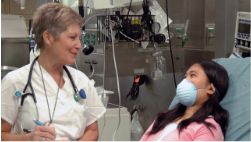|
SECTION II. COMMUNICATION SKILLS
1-10. INTRODUCTION
If you were to try to explain the process of
human interaction, you might define it as a huge and very complex communication
system. Nevertheless, it is essential that you develop and maintain an understanding of
the methods and skills of communication in order to meet the needs of the patient.
The quality of care you can provide is, in many ways, dependent on the quality of
communication that exists between you and your patient. Through your direct contact,
the patient must perceive your intentions of support and your positive expectations. You
must accurately assess the patient's physical and emotional symptoms.
Communication has only taken place if the message being sent was accurately received.
1-11. PURPOSES OF COMMUNICATION
Major Purpose. To send, receive,
interpret, and respond appropriately and
clearly to a message, an interchange of
information.
Supportive Purposes.
1-12.
ESSENTIAL COMPONENTS OF THE HUMAN COMMUNICATION SYSTEM
The essential components of communication
are:
-
Sender--the originator or source of the
idea.
-
Message--the idea.
-
Channel--the means of transmitting (either
verbally or nonverbally) the idea.
-
Receiver--someone to receive and interpret
the message.
-
Feedback--the response to the message.
|

The quality of care you can
provide is, in many ways, dependent on the quality of communication that
exists between you and your patient.
|
|
|
1-13.
VERBAL AND NONVERBAL METHODS OF COMMUNICATION
Verbal Communication. Verbal
communication refers to the use of the spoken word to acknowledge, amplify, confirm,
contrast, or contradict other verbal and nonverbal messages.
Nonverbal Communication. Nonverbal
communication refers to an
exchange of information without the exchange
of spoken words (facial expressions, body language, etc.).
Essential Relationship. Verbal
communication is always accompanied by nonverbal expression. Even
no expression tells the other person something.
1-14. METHODS OF NONVERBAL COMMUNICATION
Rapport. The harmonious feeling
experienced by two people who hold one
another in mutual respect, acceptance, and
understanding.
Empathy.
-
Empathy is that degree of understanding,
which allows one person to experience how, another feels in a particular
situation.
-
Empathy is neither sympathy (feeling
sorry for another person) nor compassion (that quality of love or
tenderness that causes one person to suffer along with another).
|

Remember that actions
speak louder than words. A person will generally pay more attention to what
you do than what you say. |
|
|
Body Language. Remember that actions
speak louder than words. A
person will generally pay more attention to
what you do than what you say. Think about the following nonverbal messages and what
they might reveal.
-
Facial expressions (smile, frown, blank
look, grimace).
-
Gestures/mannerisms (fidgeting, toe
tapping, clenched fists).
-
Eye behaviors (avoiding eye contact,
staring, wide eyes).
-
Use (and avoidance) of touch or physical
contact.
-
Posture (erect, slouching, leaning
toward/away from someone).
-
Walk.
Silence. Silence can be an extremely
effective communication tool. It can be
used to express a wide range of feelings.
-
Silence can be used to communicate the
deepest kind of love and devotion, when words are not needed.
-
Silence can be a cold and rejecting sort
of punishment, the "silent treatment" received for coming home late or
forgetting an anniversary.
-
Silence can be used in an interview or
conversation to encourage the other person to "open up." Conversely, it can
be used to intentionally create anxiety and discomfort in the other person.
Listening. As a patient speaks,
think about what he must be feeling.
Sometimes, as a listener, you must cut
through layers of words to get to the real message. You must read between the lines.
Pick up the underlying meaning of the message (intent); don't rely entirely upon
the obvious or superficial meaning (content).
1-15.
GUIDELINES FOR COMMUNICATING WITH PATIENTS AND THEIR FAMILIES
Convey to the patient and family that they
are important to you and that you want to help them. There are many ways to do
this; you must do what is comfortable and natural for you. However, there are some
things everyone can do.
-
Convey honesty and trustworthiness.
-
Try not to overwhelm the patient with
embarrassing or personal questions. When it is necessary to ask
personal questions, explain why and keep it short and matter-of-fact.
-
Don't make promises you can't keep. If
you say you are going to do something, make every effort to do it or see
that it gets done.
-
Try to be there when you say you will. If
you are late, explain why.
-
Communicate with each patient as an
individual. (This is especially important in a hospital setting, where patients often
experience a loss of identity.) In order to do so, you must try to get to know the patient.
Listen to him. Put yourself in his place.
-
Accept and respect the patient despite the
symptoms of his illness.
1-16. TECHNIQUES FOR COMMUNICATING WITH PATIENTS
|

Sit down when speaking to the
patient. Although you probably have dozens of things you need to be
doing at that moment, try to relax. |
|
|
Establishing the
Setting.
-
Provide a comfortable environment
(lighting, temperature, furnishings).
-
Establish a relaxed, unhurried setting.
-
Sit down when speaking to the patient.
Although you probably have dozens of things you need to be doing at that
moment, try to relax. Don't stand at the doorway or sit on the edge of your seat, as
if you are preparing to jump and run as soon as you can get away.
-
Face the speaker and maintain eye
contact.
-
Provide for privacy.
-
Avoid interruptions and other distracting
influences.
Verbal Communication Skills.
-
Let the patient do the talking.
-
Keep questions brief and simple.
-
Use language that is understandable to
the patient. Avoid acronyms and medical/nursing jargon if the patient is
nonmedical.
-
Ask one question at a time. Give the
patient time to answer.
-
Clarify patient responses to questions,
not just for your own use, but also to let the patient know that you are
listening (be sure you really are) and that you understand.
-
Avoid leading questions. You want the
patient to tell you what he is feeling, not what he thinks you want to hear.
So avoid putting words in his mouth. For example, it might be better to ask, "How are
you feeling?" rather than "I suppose you're feeling rested after your nap."
-
Avoid how or why questions; they tend to
be intimidating.
-
Avoid the use of cliché statements like,
"Don't worry; it'll be all right." or "Your doctor knows best."
-
Avoid questions, which require only a
simple "yes" or "no" response. You want to encourage the patient to talk to
you.
-
Avoid interrupting the patient. If you
need to ask a question, wait until he has completed his thought.
|

You can
reflect on what you think the patient is feeling. "It sounds like you're
concerned about your family." or "I don't think you're very happy about
this." |
|
|
Interviewing Techniques. The
following terms represent skills often used to
foster better communication. Before using
these techniques, remember that you must do what feels comfortable and natural to you.
Even though you may have the best of intentions, if you do not sound sincere, what
are the chances of someone really opening up to you? Also, keep in mind that your
patients are individuals; if you sense that a particular patient may not respond well to a
certain technique, you are probably right.
-
Reflection. Repeating content or
feelings. You might simply repeat what the patient has said, to give him time
to mull it over or to encourage him to respond. Or, and often more effectively, you
can reflect on what you think the patient is feeling. "It sounds like you're concerned
about your family." or "I don't think you're very happy about this." By reflecting on his
feelings, you may be encouraging him to talk about something he may have been hesitant to
bring up himself. Or you may be helping the patient to identify his own
feelings about something.
-
Restating. Rephrasing a question or
summarizing a statement. "You're asking why these tests are needed?" or "In
other words, you think you're being treated like a child."
-
Facilitation. Occasional brief responses,
which encourage the speaker to continue. A nod of the head; an occasional
verbal cue, such as "go on" or "I see;" and maintaining eye contact throughout the
conversation all imply that you are listening and that you understand.
-
Open-ended questions. Questions that
encourage the patient to expound on a topic. If you want to encourage
the patient to speak freely, you might ask "How are you feeling?" rather than "Are you
in pain?"
-
Closed-ended questions. Questions, which
focus the patient on a specific topic. If you want a short, straight
answer, ask a question which will allow only for a direct response, such as "When was your
accident?" or "Do you have pain after eating?"
-
Silence. A quiet period that allows a
patient to gather his thoughts. Of course, this would be an occasional practice,
used when you feel that the patient could use a little time to think about his response
to a question or just to think.
-
Broad openings. A few words to encourage
the patient to further discuss a topic; for example, "and after
that..." or "you were saying..."
-
Clarification. Statements or questions
that verify a patient's concern or point. "I'm a bit confused about...Do you
think you could go over that again please?"
1-17. THERAPEUTIC COMMUNICATION
-
Practicing therapeutic communication is in
many ways simply developing a good bedside manner. When your patient asks
you a question or discusses something with you, be careful to respond in a helpful
and caring manner. By encouraging the patient to speak up, you are probably helping
him/her to decrease his level of stress and thereby his recovery time.
-
Study the
techniques discussed in paragraphs 1-15 and 1-16. Become familiar enough with them so
that they become a natural part of your conversations.
-
When your patient communicates with you,
you must be able to correctly observe, evaluate, and respond. Your
knowledge, understanding, and skill in human relations will enable you to do so.
1-18.
CRITICAL ELEMENTS OF EFFECTIVE THERAPEUTIC
COMMUNICATION
Be able to decipher the patient's message.
Get to know the patient well enough to discover the underlying meaning
(intent) of his/her communication. Be alert and perceptive enough to pick up the correct
message. Many people feel uncomfortable talking about their feelings,
especially if they are trying to be "good patients." Learn to "read between the lines."
|

When communicating with patients, each
Practical Nurse has to find the ways that are the most effective for the
people and circumstances concerned. |
|
|
Be realistic in your relationships with
people; avoid making assumptions or judgments about your patients' behavior. If
you have negative thoughts about something a patient says or does, try to keep
in mind that he is an adult, responsible for making his own decisions. You do not want him
to feel he must conceal anything from you. You want him to see that you will accept
him for what he is; you will allow him his own identity.
Be emotionally mature enough to postpone
the satisfaction of your own needs in deference to the patient's. Find sources
other than the therapeutic relationship to meet your own needs.
1-19.
NURSING INTERVENTION WITH PATIENTS WITH
SPECIAL COMMUNICATION NEEDS
Blind Patients.
-
Always speak to the patient when you
enter the room so he will know who is there.
-
Speak directly to the patient; do not turn
your back.
-
Speak to the patient in a normal tone of
voice; he is blind, not deaf.
-
Speak to the patient before touching him/her.
-
Offer to help with arrangements for patients
who may enjoy hearing tapes or reading Braille literature.
Deaf Patients.
-
Look directly at the patient when
speaking with him/her.
-
Do not cover your mouth when speaking
because the patient may read lips.
-
If the patient does not lip-read, charts
with pictures may be used, or simply writing your questions or comments on
a piece of paper may be helpful.
-
Charts with hand signs are available at the
local society for deafness and/or hearing preservation.
Patients Speaking a Foreign Language.
-
Obtain a translator if possible. The Red
Cross or the Patient Administration Division (PAD) may be of
assistance.
-
Have a chart with basic phrases in
English and the foreign language.
-
Consider using charts with pictures.
1-20. CLOSING
When communicating with patients, each
Practical Nurse has to find the ways that are the most effective for the people
and circumstances concerned. If the Practical Nurse tries to express care and concern for
the patient and can communicate well verbally and nonverbally, the nurse-patient
relationship will thrive.
The Brookside
Associates Medical Education Division is dedicated to the development and
dissemination of medical information that may be useful to medical professionals
and those in training to become medical professionals. This website is
privately-held and not connected to any governmental agency. The views expressed
here are those of the authors, and unless otherwise noted, do not necessarily
reflect the views of the Brookside Associates, Ltd., any governmental or private
organizations. All writings, discussions, and publications on this website are
unclassified.
© 2007 Medical Education
Division, Brookside Associates, Ltd. All rights reserved
Other
Brookside Products
Contact Us

Advertise on this Site
|
|





